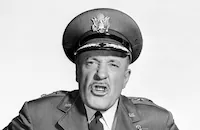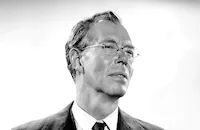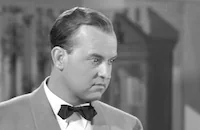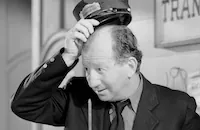Living It Up

Brief Synopsis
Cast & Crew
Norman Taurog
Dean Martin
Jerry Lewis
Janet Leigh
Edward Arnold
Fred Clark
Film Details
Technical Specs

Synopsis
One day in Desert Hole, New Mexico, bumbling train station attendant Homer Flagg impulsively hops a passing train, hoping it will take him to an exciting new life in New York. Instead, Homer is chased off the train by an MP and jumps into an abandoned automobile near the tracks. Oblivious to a sign on the front grille identifying the car as radioactive, Homer drives off toward the Los Alamos nuclear test site and ends up at a gas station. When Homer finally notices the sign, he faints, and the next day, his imminent death from radiation poisoning is announced in newspapers across the country. In New York, Morning Chronicle reporter Wally Cook convinces her wary publisher, Oliver Stone, that Homer's terminal illness would be great fodder for a series of articles and talks him into inviting Homer to spend his last days in New York at the paper's expense. Homer, meanwhile, learns from his incompetent doctor, Steve Harris, that he was misdiagnosed and is not dying after all. Homer is unhappy about the news, as the railroad was about to give him $300 to go to New York, and reluctantly returns to the depot. There, Homer meets Wally as she is disembarking, and when she tells him about The Chronicle's offer, cannot bring himself to admit he is healthy. Homer races to Steve's office and begs him not to send his amended medical report to the railroad, but Steve refuses until Wally shows up and enchants him. Steve then insists on accompanying Homer to New York, and on the plane there, knocks Homer out with some pills and flirts shamelessly with an unreceptive Wally. In New York, Homer receives a hero's welcome and is put up at the Park Ritz Hotel, where he begins ordering room service, a new wardrobe and other expensive amenities. Steve cautions Homer to act sick, but Homer has a difficult time suppressing his excitement during highly publicized appearances at Yankee Stadium and the Wonderland Ballroom. There, while Steve tries to romance Wally, Homer dances a wild jitterbug after a waiter slips him some vodka and champagne, then collapses on the floor. The next day, at the hotel, Steve ministers to a hungover Homer, whose guilt at deceiving Wally and the world is starting to take its toll. To please Steve, Homer agrees to tell Wally that Steve loves her and wants to marry her, even though he is in love with her, too. When Wally shows up and admits to Homer that she is going to talk to the governor about erecting a statue in his honor, Homer protests that he is unworthy. Seeing his opportunity, Homer then tells Wally how much Steve loves her, but Wally insists that she loves Homer and wants to marry him. Swept up in the moment, Homer agrees and later rejects Steve's angry suggestion that he tell Wally the truth to ensure that she is marrying him for love. Just before the ceremony, however, Homer overhears Wally confess to Steve that she actually loves him but wants to make Homer's last days happy. At the altar, Homer refuses to say "I do" and runs back to the hotel to pack. When Wally, Oliver and the mayor demand to see him, Homer hangs from a chandelier and pretends he is a fighter pilot, hoping to convince them that he has gone insane. His act works, but Wally is so filled with pity that she talks Oliver into paying to have the top radiation sickness experts flown to New York. Wally distracts Steve, who has stipulated that only he be allowed to treat Homer, long enough to kidnap Homer and take him to the hospital where the foreign doctors are to examine him. To prevent the examination, Steve tries to knock Homer out, but is himself knocked out. When the unconscious Steve is mistaken for Homer and wheeled in to be X-rayed, Homer dons different disguises and impersonates each of the three doctors separately in an attempt to fool them into diagnosing radiation sickness. The doctors deduce Homer's scheme, however, and inform Oliver that he is as healthy as a horse. Unaware they have been exposed, Steve comes up with the idea to publicly "cure" Homer, and the two begin to celebrate their cleverness. Wally arrives unexpectedly at the hotel, however, and reveals that she is on to them. Though relieved that Homer is well, Wally demands that he fake committing suicide, then slip out of town. As directed by Wally, Homer leaves a suicide note in his hotel room and goes with Steve and a camera-wielding Wally to "drown" himself in the river. The note is soon found by some Boy Rangers, who notify the fire department and Oliver. Determined to see Wally's scheme succeed, the mayor, Oliver and his "sluggers" race to the river to cajole the frightened Homer into jumping before the fire department arrives to save him. Homer instead falls into the river, crashing through his rescue rowboat. The rowboat sinks, and later, after Homer's grand public funeral, Homer and Steve, who has married Wally, undertake the jobs assigned to them by the mayor--street cleaning.

Director

Norman Taurog
Cast

Dean Martin

Jerry Lewis

Janet Leigh

Edward Arnold

Fred Clark

Sheree North

Sammy White
Sid Tomack

Sig Ruman

Richard Loo
Raymond Greenleaf

Walter Baldwin
Fay Roope

Eduard Franz
Marla English

Kathryn Grandstaff
Emmett Lynn
Dabbs Greer
Clancy Cooper
Max Power
Don Dunning
Al Hill
John Alderson
Booth Colman
Stanley Blystone

Fritz Feld
Torben Meyer
Richard Barron
Art Baker

Grady Sutton
Norman Leavitt

Frankie Darro
Jean Del Val
Ralph Montgomery
Don Bender
Lane Chandler
Jac Fisher
Jack Bruce
George Davis
Mike Mahoney

Michael O'hara
Gino Corrado
Ted Thorpe
Bill Cartledge
Bobby Barber
Ray Page
Jack Stoney
Donald Kerr
Stephen Wootton
James H. Horan
Fred Sweeney

Hank Mann
Audrey Hansen
Gretchen Houser
Roger Creed
Cosmo Sardo
Louise Decarlo
Tommy Summer
Rudy Makoul
Paul Kruger
Frank Branda
Fred Zendar
Charles Collins
Crew
A. H. Barnett
Claire Behnke
Nick Castle
Sam Comer
Farciot Edouart
Daniel Fapp
John P. Fulton
Gene Garvin
Edith Head
Charles Henderson
Bob Hilliard
Clem Jones
Paul Jones
Wallace Kelley
Emile Kuri
Herman Lewis
Rudy Makoul
Archie Marshek
Gene Merritt
Jack Mintz
Michael D. Moore
Richard Mueller
Albert Nozaki
Hal Pereira
Don Robb
Jack Rose
Arthur Rosson
Walter Scharf
Melville Shavelson
Dave Silver
Keith Stafford
Jule Styne

Videos
Movie Clip




Trailer
Hosted Intro
Film Details
Technical Specs

Articles
Living It Up
In the original 1937 satire penned by Ben Hecht, Carole Lombard is a small town girl misdiagnosed with radiation poisoning by the local doctor. Fredric March is the jaded big city reporter who wants to publicize her plight and treat her to a trip to New York. For Living It Up, the screenwriters altered the main character's genders with Jerry Lewis in the role of the supposedly dying Homer Flagg and Janet Leigh as the winsome reporter Wally. The doctor, another key character, was refashioned for Dean Martin who became a skirt-chasing physician named Steve. Although Homer and Steve find out that the original diagnosis is incorrect, they decide to take advantage of the free trip, so Homer can see the sights and the doctor can see more of Wally.
In between wooing Wally and avoiding Dr. Egelhofer (another doctor sent to verify Homer's sickness), Martin manages to fit in some swinging songs, including "How Do You Speak to an Angel," "Money Burns a Hole in My Pocket," and a duet with Lewis, "Every Street's a Boulevard." Homer, meanwhile, entertains a dance contest winner (Sheree North in her film debut) and an incredibly sexy and energetic jitterbug number ensues. The Paramount publicity department touted North's bit as "the screen's first rock and roll number" despite the fact that the jitterbug wasn't a new Elvis Presley inspired dance but a holdout from the pre-WWII era.
Besides the musical numbers, there is plenty of goofy comic banter. "You're going all the way to New York because you have radiation poisoning," reporter Wally tells Homer. Homer's quick reply: "How far can I go on a sinus condition?" Slapstick is also part of the mix although for one scene, the usually unflappable Martin almost lost his cool. The scene called for him to "accidentally" catch a ride on a serving cart but jump off before it crashes into a door. But director Norman Taurog insisted that it be done over and over again until it was "just so," much to Martin's annoyance.
Lewis and Martin worked with director Taurog six times in their movie careers, most notably on The Stooge (1953) and Jumping Jacks (1952). After Living It Up, he would direct the pair twice more in Pardners (1956) and You're Never Too Young (1955), which was a remake of The Major and the Minor (1942).
Janet Leigh was also an old acquaintance of the team. Lewis and Martin had known Leigh and her husband Tony Curtis for some years before Living It Up, and in fact, Lewis and his wife had been best man and matron of honor at Leigh's wedding to Curtis. They also appeared in many of the zany home movies that Lewis directed with his friends during this time.
But Leigh did have some misgivings about her part as the New York reporter. In her autobiography, There Really Was a Hollywood, she wrote, "The dialogue was laced with caustic one-liners; Eve Arden manages this so effectively, but it isn't my way - glibness doesn't sit well on my shoulders. Comedy for me has to come out of a situation, not just delivering witty lines. Norman agreed completely, recognizing what was natural for me."
Living It Up was made at the peak of the Martin and Lewis popularity. The duo started as a team in 1946 and started making movies three years later. They remained the world's top box-office earners from 1950 to 1956, the year the pair would go their separate ways. The professional break-up was still two years away at the time of Living It Up, but the strains were already beginning to show.
Leigh remembered in her autobiography that the two men kept their distance on the set of Living It Up and didn't socialize outside of work. "Dean had his group and Jerry had his group and all of that." But Leigh writes that despite differences, the two men created movie magic in their own ways on the set. "Dean was a natural ¿ relaxed, easygoing, open, and sexy ¿ and it resulted in a seemingly effortless, honest, warm portrayal. Jerry came across an inventive buffoon, and more. He's a much better actor than he has been given credit for."
Lewis told filmmaker Peter Bogdanovich in 2000 that the change in the relationship started to fester around 1954. "We had outside factions that were envious of our relationship," he said in an interview in Bogdanovich's book, "Who the Hell's In It." "Whatever mean-spirited people do, we were getting the ass-end of it."
After the break-up, Martin and Lewis each had successful careers on their own, but many critics still single out their partnership in movies --including Living It Up -- as a high point in cinematic comedy. Producer: Paul Jones
Director: Norman Taurog
Screenplay: Ben Hecht, Jack Rose, Melville Shavelson, James H. Street
Cinematography: Daniel L. Fapp
Film Editing: Archie Marshek
Art Direction: Albert Nozaki, Hal Pereira
Music: Walter Scharf, Jule Styne
Cast: Dean Martin (Dr. Steve Harris), Jerry Lewis (Homer Flagg), Janet Leigh (Wally Cook), Edward Arnold (The Mayor), Fred Clark (Oliver Stone), Sheree North (Jitterbug Dancer).
C-95m.
by Amy Cox

Living It Up
Quotes
Trivia
Notes
Living It Up was based on the 1953 Broadway musical Hazel Flagg, which was based on the 1937 David O. Selznick-United Artists film Nothing Sacred (see AFI Catalog of Feature Films, 1931-40). Nothing Sacred, in turn, was suggested by the short story "Letter to the Editor" by James H. Street. Nothing Sacred, which was directed by William Wellman, was written by Ben Hecht, who also wrote the book for Hazel Flagg and receives onscreen credit for Living It Up. Carole Lombard played the dying "Hazel" in the 1937 film and Fredric March portrayed "Wally." Sig Ruman played "Dr. Egelhofer" in both the 1937 and 1954 pictures. Dancer Sheree North (1933-2005), in her first significant screen role, also played the star jitterbugger in Hazel Flagg. Only three songs from the Broadway show are performed in Living It Up-"Every Street's a Boulevard in Old New York," "How Do You Speak to an Angel?" and "You're Gonna Dance with Me." A snippet of the show's song "Who Is the Bravest" is also heard in the film.
Hollywood Reporter news items add the following actors to the cast of Living It Up: Hazel Boyne, Philo McCollough, Tom Tutwiler, Jack Gaines, Jr., Stuart Holmes, Lucille Lamarr, Lou Brown, Bill Roberts, Helen Dickson, Millicent Patrick and Jane Easton. The appearance of these actors in the final film has not been confirmed. According to a April 26, 1954 Los Angeles Times item, a special preview of the picture was held at George Air Base near Victorville, CA. As noted in a July 16, 1954 Hollywood Reporter news item, the film then had a special two-day premiere in Atlantic City. Modern sources claim that, at Jerry Lewis' behest, the film was screened in June 1954 at the Brown Hotel, where Lewis had performed as a teenager, at Loch Sheldrake in the Catskill Mountains. The picture was re-released in September 1965.

Miscellaneous Notes
Released in United States Spring May 1954
Released in United States Spring May 1954















